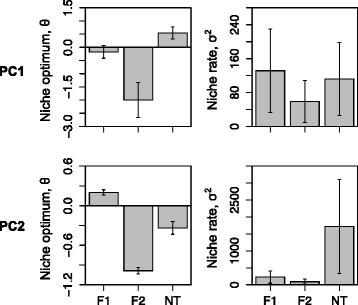Phylogeny and biogeography of Primula sect. Armerina: implications for plant evolution under climate change and the uplift of the Qinghai-Tibet Plateau
- PMID: 26275399
- PMCID: PMC4537560
- DOI: 10.1186/s12862-015-0445-7
Phylogeny and biogeography of Primula sect. Armerina: implications for plant evolution under climate change and the uplift of the Qinghai-Tibet Plateau
Abstract
Background: The historical orogenesis and associated climatic changes of mountain areas have been suggested to partly account for the occurrence of high levels of biodiversity and endemism. However, their effects on dispersal, differentiation and evolution of many groups of plants are still unknown. In this study, we examined the detailed diversification history of Primula sect. Armerina, and used biogeographic analysis and macro-evolutionary modeling to investigate a series of different questions concerning the evolution of the geographical and ecological distribution of the species in this section.
Results: We sequenced five chloroplast and one nuclear genes for species of Primula sect. Armerina. Neither chloroplast nor nuclear trees support the monophyly of the section. The major incongruences between the two trees occur among closely related species and may be explained by hybridization. Our dating analyses based on the chloroplast dataset suggest that this section began to diverge from its relatives around 3.55 million years ago, largely coinciding with the last major uplift of the Qinghai-Tibet Plateau (QTP). Biogeographic analysis supports the origin of the section in the Himalayan Mountains and dispersal from the Himalayas to Northeastern QTP, Western QTP and Hengduan Mountains. Furthermore, evolutionary models of ecological niches show that the two P. fasciculata clades have significantly different climatic niche optima and rates of niche evolution, indicating niche evolution under climatic changes and further providing evidence for explaining their biogeographic patterns.
Conclusion: Our results support the hypothesis that geologic and climatic events play important roles in driving biological diversification of organisms in the QTP area. The Pliocene uplift of the QTP and following climatic changes most likely promoted both the inter- and intraspecific divergence of Primula sect. Armerina. This study also illustrates how niche evolution under climatic changes influences biogeographic patterns.
Figures





References
-
- Hoorn C, Wesselingh FP, Ter Steege H, Bermudez MA, Sevink J, et al. Amazonia through time: Andean uplift, climate change, landscape evolution, and biodiversity. Science. 2010;330(6006):927–31. - PubMed
-
- Favre A, Päckert M, Pauls SU, Jähnig SC, Uhl D, Michalak I, et al. The role of the uplift of the Qinghai-Tibetan plateau for the evolution of Tibetan biotas. Biol Rev. 2014;90(1):236–53. - PubMed
-
- Mayr E. Animal Species and Evolution. Cambridge, Mass: Harvard University Press; 1963.
-
- Coyne JA. Genetics and speciation. Nature. 1992;355:511–5. - PubMed
Publication types
MeSH terms
LinkOut - more resources
Full Text Sources
Other Literature Sources

